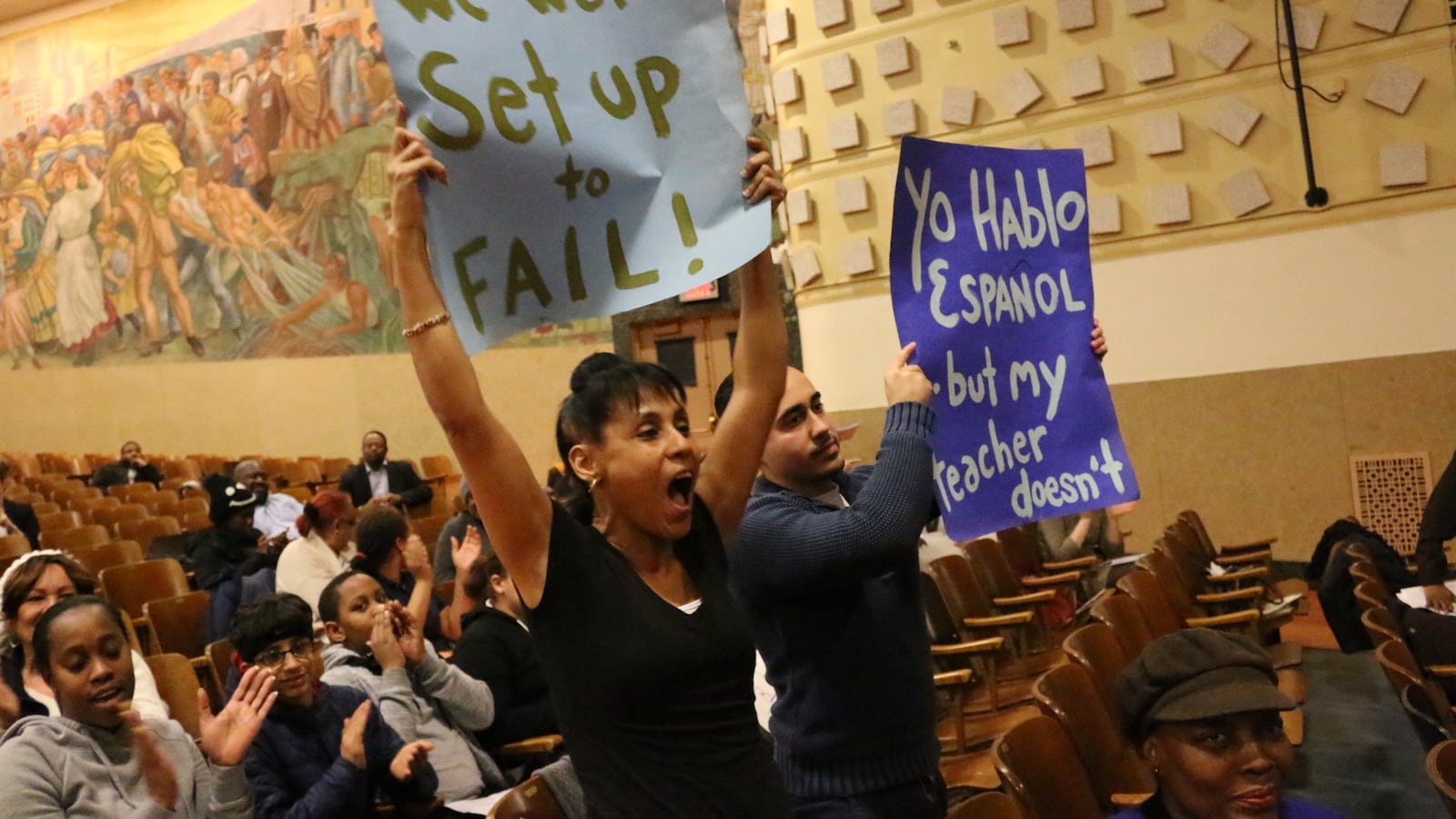After outcry from some school communities, and near silence from others, the city’s plan to close five schools in its signature turnaround program was approved Wednesday night.
The vote from the Panel for Educational Policy, which must sign off on school closures, came after nearly four hours of angry comments from parents, educators, and elected officials, many of whom said the city had gone back on its promise of giving their schools time to improve.
“They buried us while we were breathing,” said Deidre Walker, a math teacher at J.H.S. 145, a Bronx middle school that will now close at the end of the school year. “The resources weren’t given.”
All five schools are part of Mayor Bill de Blasio’s Renewal initiative, a program designed to flood them with additional academic resources and social services to help sow improvements rather than closing them outright — the approach favored by the Bloomberg administration.
Given previous mergers and closures, the education panel’s vote will mean that, starting next school year, 78 schools will remain in the program, down from an original 94.
Throughout the closure process, city officials told the schools that they had shed too many students and were too low-performing to remain open. The six Renewal schools the city has identified for closure this year — including the five approved Wednesday night — all have fewer students than when the program began in the 2014-15 school year.
And all five schools are clearly struggling, according to the city’s metrics, which is not surprising since the program explicitly targeted bottom-performing schools. At the Essence School in Brooklyn, one of the schools that will be closed, 5 percent of its students were proficient in math or reading last school year — far below city averages.
But the schools slated for closure are not necessarily the lowest-performing ones in the program, a fact that was repeatedly raised Wednesday night. Twenty-six Renewal schools met fewer benchmarks than Essence did last year, for instance, according to city figures.
Before the vote, Schools Chancellor Carmen Fariña defended the closure plan, saying it is in “the best interests of children” — a claim that was immediately interrupted with boos from the audience.
An education department spokeswoman, Devora Kaye, previously said that multiple factors were taken into account beyond those metrics, including feedback from families, staff turnover, history of interventions or improvement, and “research from schools in similar situations.”
The six Renewal schools approved for closure will be shuttered immediately, starting next academic year, rather than being phased out.
Two of them are junior high schools in the Bronx: J.H.S.145 Arturo Toscanini and J.H.S 162 Lola Rodriguez de Tio, a “persistently struggling” school the panel had already voted to close as part of a deal with the state.
Two high schools in the Bronx are also slated for closure: Leadership Institute and Monroe Academy for Visual Arts and Design; as are two Brooklyn middle schools: M.S. 584 and the Essence School.
The city held hearings at each of those schools in advance of the vote, some of which attracted dozens of speakers imploring education officials to reconsider, or at least postpone, the decision.
A consistent complaint at those meetings was that the city’s closure plans clashed with promises that schools would have three years to improve. The program is still several months shy of its third birthday, and many of the social services that schools received have only been in place for a year and a half.
Among the most contentious closures was J.H.S. 145. Multiple teachers and parents said the city neglected to provide essential resources. Nearly half the students are English learners, and while the school is supposed to offer “transitional bilingual education,” there is just one bilingual teacher and one ESL teacher on staff.
At the meeting, Chancellor Fariña acknowledged staffing problems at the school — “I’m not going to deny that we haven’t been able to fill all the vacancies” — but she added that the school was provided “a tremendous amount of resources.”
Some parents have also expressed concern over where their children will go to school next year, a decision that will have to be made quickly. A Chalkbeat analysis found that many students who left closed Renewal schools wound up at schools that performed better than the ones they left — but were often below the city average.
While some school communities showed up in force to oppose the closures, others have been relatively quiet. At Leadership Institute, a Bronx high school, a recent closure hearing ended after just a few minutes without any members of the public showing up to comment.
Wednesday’s vote also approved the merger of three other Renewal schools: Frederick Douglass Academy IV Secondary School (to be merged with the Brooklyn Academy of Global Finance), Automotive High School in Brooklyn (with Frances Perkins Academy), and M.S. 289 Young Scholars Academy of the Bronx (with North Bronx School of Empowerment).
Automotive is the only merged school that will absorb the school with which it’s being merged, and stay in the Renewal program.
Finally, the panel also approved truncating the middle school grades at two Brooklyn Renewal schools: P.S. 306 Ethan Allen and P.S. 165 Ida Posner.

